![]()
|
|
|
Stoke-on-Trent - Potworks of the week |
Brick House Works (Bell Works), Burslem
The
Brick House Works, known as the 'Bell Works' after Josiah Wedgwood installed a
bell to call
his potters to work.
|
According to Jewitt "The Life of Josiah Wedgwood" the Brick House Works were owned by a Mr. John Bourne of Newcastle, from him the property passed to his grandson Mr. John Adams of Cobridge.
|
|
From |
To |
Occupier |
Comments |
| 1763 |
1770 |
Josiah Wedgwood |
Wedgwood
rented the works from the Adams family of potters. |
| 1770 |
1774 |
William Adams |
William Adams took the works for himself but he relet them in 1774 |
| ? |
1822 |
William Bourne (& Co) |
After Wedgwood relocated to Etruria the Brickhouse Works were occupied by William Bourne an earthenware manufacturer - he was tenant there in 1809. |
| 1822 |
|
Bourne & Cormie |
William Bourne entered into partnership with a potter named Cormie. The partnership appears to have been short lived. |
| 1836 |
1839 |
Beech & Jones |
The works having remained unoccupied for some time were divided. One part was continued as a pottery and was taken by Beech & Jones - some of the land was used for the building of the Independent chapel, which was built in 1837. Other parts were let to other traders. |
| 1839 |
1853 |
William Beech |
After the partnership between Beech & Jones was dissolved in 1839, William Beech continued on his own and in 1846 he expanded the business, taking over the tenancy of the remaining premises. |
| 1853 |
1855 |
Beech & Brock |
William Beech entered into a short lived partnership with a William Brock. |
| 1855 |
1864 |
William Beech |
After the partnership between Beech & Brock was dissolved in June 1855, William Beech continued on his own until his death in 1874. |
| 1866 |
1873 |
Jane Beech |
William
Beech was succeeded in 1866 by Jane Beech. |
| 1873 |
1876 |
Beech & Podmore |
In 1876 the business closed - part of the premises was purchased by the local Board of Health to build a covered market and the rest of the works was taken down. Beech
and Podmore may have continued in business togther for a few more
years. |
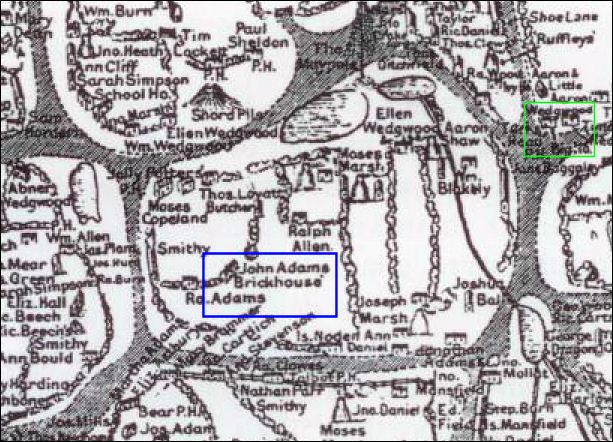
Burslem town centre in
1750 - from a plan by Enoch Wood
John Adams Brickhouse is highlighted -it would be another 13
years before
Josiah Wedgwood started potting here
(in
the top right is the 'Big House' of Thomas and John Wedgwood
- which was just being built when this plan was drawn)

Burslem town centre one
hundred years later in 1851


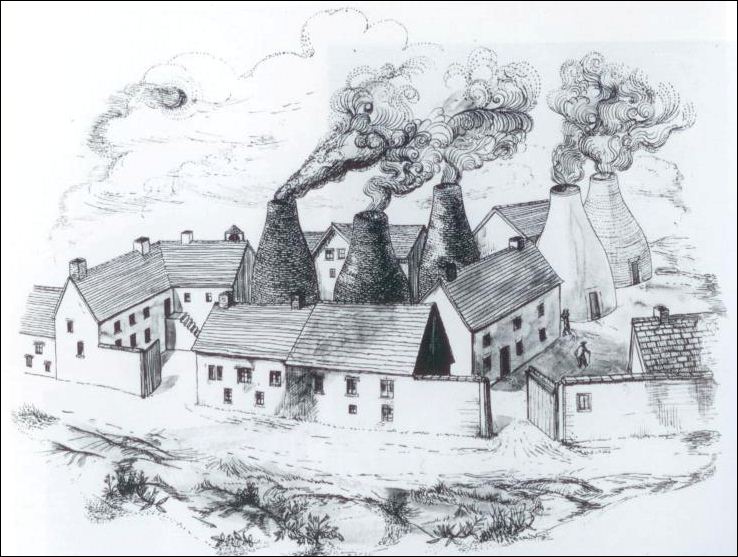
The Brick House Works,
Burslem, Stoke-on-Trent
|
"One of the improvements at Brick House Works was instrumental in introducing a new kind of discipline amongst Josiah's workers. He had a bell rigged to a turret on one of his workshops across the yard from his house and every morning at quarter to six he rang it to tell his employees it was time to start work.
Installing the bell was Josiah's first management innovation. He had long known the importance of discipline in the workforce, especially when it came to regulating working hours and distracting dilatory workers from the allure of the alehouses. Gone were the days when the rise and fall of the sun dictated the potters' working day. The day had to begin and end for the team in unison, or time and productivity was lost; it was up to Josiah to set times, shortening lunch breaks or prolonging the working day according to demand." Brian Dolan 'Josiah Wedgwood, Entrepreneur to the Englightenment" p146 |
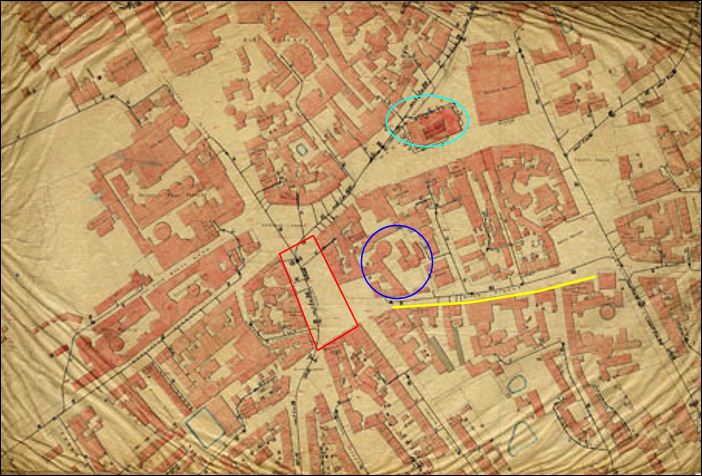
1851 map of Burslem town
centre
from: Staffordshire
Past Track
Blue
circle = The Bell Works
Yellow line = Queen Street
Light blue oval = The Town Hall
Red outline = St. John's Square
|
The layout of the town is generally the same as it is today.
Market House is now roughly the site on which Ceramica is situated and The Marquis of Granby public house is now called the Saggar Maker's Bottom Knocker. |
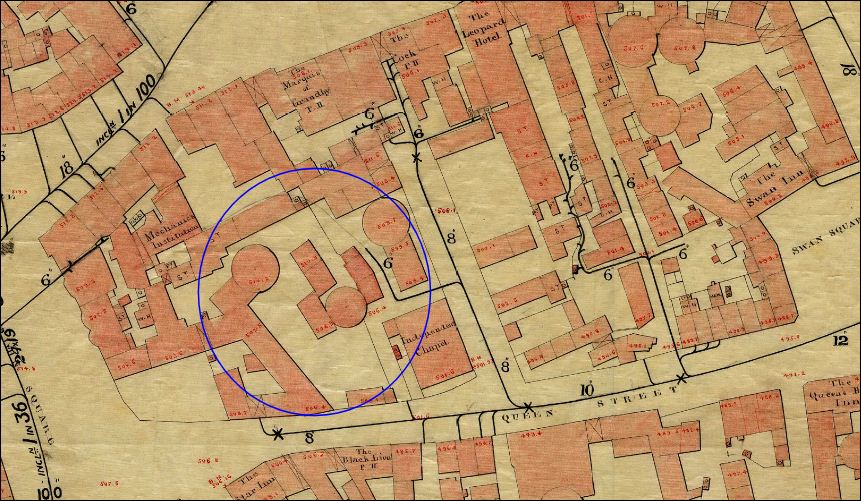
close up of 1851 map - the
location of the Bell Works is shown in blue
|
In 1836 the Bell Works, having remained unoccupied for some time, were divided.
|
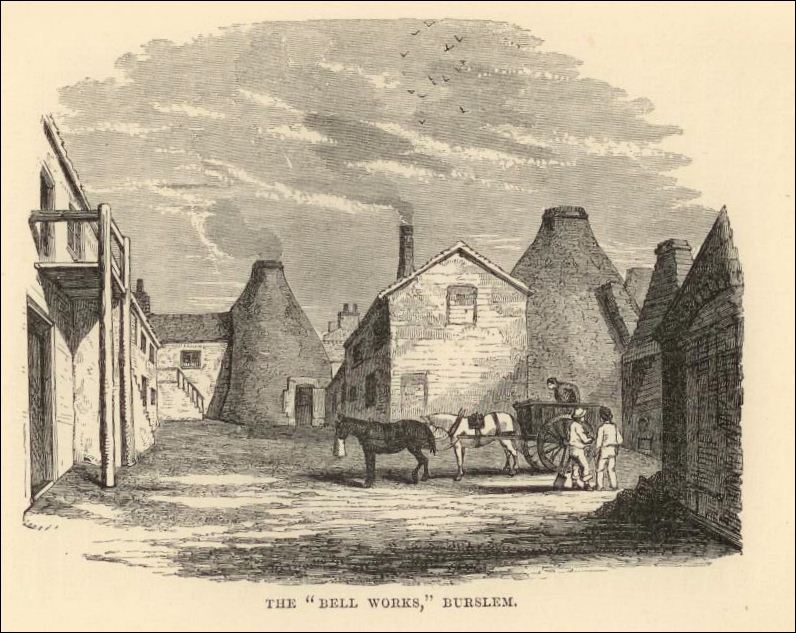
The 'Bell Works' Burslem
c.1865
from The Life of Josiah Wedgwood by L. Jewitt
|
Related pages
|